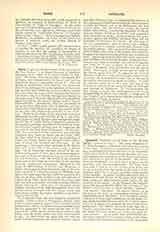

Gamans, JEAN, b. July 8, 1606, at Ahrweiler (according to other sources at Neuenahr, about two miles from Ahrweiler; there does not appear to exist any documentary evidence to show that he was born at the little town of Eupen, as stated in the “Bibliotheque des ecrivains de la Compagnie de Jesus”); d. at the College of Aschaffenburg near Frankfort, November 25, 1684. He entered the Society of Jesus at Trier on April 24, 1623, having studied the humanities for five years and philosophy for two years at Cologne, where he had received the degree of Master of Arts. After making his novitiate, he devoted several months to a revision of his philosophical studies, and subsequently, from 1626, spent five years teaching in the College of Wurzburg, conducting his pupils through the five classes which comprised the complete course in humanities. He then studied theology for a year at Mainz (1631), after which, the houses of his province of the Upper Rhine being suppressed during the war with Sweden, he continued his theological studies for three years at Douai, where he was ordained priest on March 26, 1633. These studies having come to an end in 1634, and being followed doubtless by the third year of probation, he discharged for several years the duties of chaplain to the land and naval troops in Belgium and Germany. We find him mentioned under this title (Castrensis) in the catalogue of the Flandro-Belgian province for 1641 as being attached to the professed house at Antwerp, where he made his profession of the four vows on December 26 of the same year. He lived here with the first two Bollandists, Jean Bolland and Godefroid Henschen, became inflamed with zeal for their work and was henceforth their assiduous collaborator, whithersoever his duty called him, but especially at Baden-Baden, where he resided for some time in order to direct the studies of the young princes of the House of Baden. He was undoubtedly there in 1641 and 1649. At the end of this latter year he resided in a missionary capacity at Ettlingen near Karlsruhe. Here we lose all sight of him until 1681, when he was attached to the College of Aschaffenburg near Frankfort, where he died November 25, 1684.
For more than thirty years, it is stated in the death notice inserted in the Annual letters of the College of Aschaffenburg for that year, he was so immersed in the hagiographical researches which he had undertaken in behalf of his associates at Antwerp that he devoted to them even the hours of the night, taking only a short rest on the floor or a strip of matting. Indeed, his name occurs very often in the “Acta SS.” at the head of documents transcribed by him, and even of commentaries written entirely by him (cf. “Bibl. des ecriv. de la C. de J”, s.v. “Gamans”). A large number of papers of this description is to be found in the vast manuscript collection of the early Bollandists preserved at the Royal Library of Brussels and in the modern Bollandist library, although the largest part of his papers, dispatched to the Bollandists after his death, were engulfed in the Main, the vessel bearing the precious freight having unfortunately sunk. Gamans had also collected a mass of material for a “Metropolis Moguntina”, which he wished to compose on the model of the “Metropolis Salisburgensis” published by Hund in 1582, and also for a history of the grand ducal House of Baden. As many as eight manuscripts of the latter work are known to exist, but no portion of it or of the “Metropolis Moguntina” has been printed.
CH. DE SMEDT

